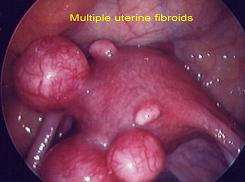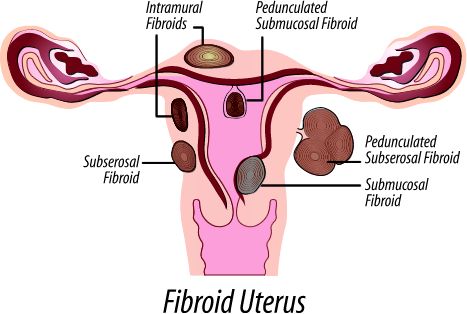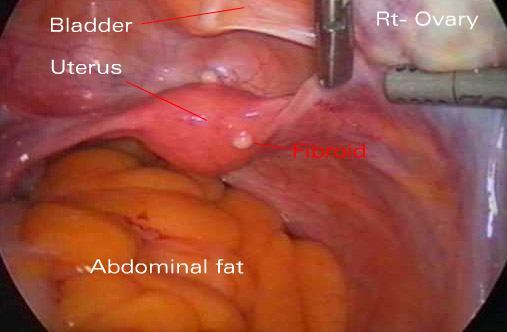
What are uterine fibroids?
Uterine fibroids (also referred to as uterine leiomyomata, uterine leiomyomas, or uterine myomas) are benign tumors that originate in the uterus (womb). Although they are composed of the same smooth muscle fibers as the uterine wall (myometrium), they are many times denser than normal myometrium. Uterine fibroids are usually round or semi-round in shape.
Uterine fibroids are often described based upon their location within the uterus. Subserosal fibroids are located beneath the serosa (the lining membrane on the outside of the organ). These often appear localized on the outside surface of the uterus or may be attached to the outside surface by a pedicle. Submucosal (submucous) fibroids are located inside the uterine cavity beneath the lining of the uterus. Intramural fibroids are located within the muscular wall of the uterus.
Why do women develop uterine fibroids and how common are they?
We do not know exactly why women develop these tumors. Genetic abnormalities, alterations in growth factor (proteins formed in the body that direct the rate and extent of cell proliferation) expression, abnormalities in the vascular (blood vessel) system, and tissue response to injury have all been suggested to play a role in the development of fibroids.
Family history is a key factor, since there is often a history of fibroids developing in women of the same family. Race also appears to play a role. Women of African descent are two to three times more likely to develop fibroids than women of other races. Pregnancy and taking oral contraceptives both decrease the likelihood that fibroids will develop. Fibroids have not been observed in girls who have not reached puberty, but adolescent girls may rarely develop fibroids.
What are the symptoms of uterine fibroids?
Most women with uterine fibroids have no symptoms. However, fibroids can cause a number of symptoms depending on their size, location within the uterus, and how close they are to adjacent pelvic organs. Large fibroids can cause:
- pressure,
- pelvic pain,
- pressure on the bladder with frequent or even obstructed urination, and
- pressure on the rectum with pain during defecation.
Abnormal uterine bleeding is the most common symptom of a fibroid. If the tumors are near the uterine lining, or interfere with the blood flow to the lining, they can cause heavy periods, painful periods, prolonged periods or spotting between menses. Women with excessive bleeding due to fibroids may develop iron deficiency anemia. Uterine fibroids that are deteriorating can sometimes cause severe, localized pain.
While fibroids do not interfere with ovulation, some studies suggest that they may impair fertility and lead to poorer pregnancy outcomes. In particular, submucosal fibroids that deform the inner uterine cavity are most strongly associated with decreases in fertility.
Do untreated uterine fibroids pose a risk?

For the most part, uterine fibroids that do not cause a problem for the woman can be left alone. In some cases, even fibroids that are not causing symptoms require removal or at least close observation. Rapid growth is a reason to watch more carefully, since a rare cancerous form of fibroid (referred to as a leiomyosarcoma) is usually a fast-growing tumor, and it cannot be differentiated from a benign fibroid by ultrasound, MRI , or other imaging studies. However, this type of tumor occurs in less than 1% of uterine fibroids. Another risk of leaving these tumors alone is that they sometimes grow to a size that eventually cause significant symptoms, thus requiring removal. If fibroids grow large enough, the surgery to remove them can become more difficult and risky. Occasionally, fibroids are the cause of recurrent miscarriages. If they are not removed in these cases, the woman may not be able to sustain a pregnancy.
What are the usual ways of diagnosing uterine fibroids?
Uterine fibroids are diagnosed by pelvic exam and even more commonly by ultrasound. Often, a pelvic mass cannot be determined to be a fibroid on pelvic exam alone, and ultrasound is very helpful in differentiating it from other conditions such as ovarian tumors. MRI and CT scans can also play a role in diagnosing fibroids, but ultrasound is the simplest, cheapest, and almost without question the best technique for imaging the pelvis. Occasionally, when trying to determine if a fibroid is present in the uterine cavity (endometrial cavity), a hysterosalpingogram (HSG) is done. In this procedure, an ultrasound exam is done while contrast fluid is injected into the uterus from the cervix. The fluid is visualized in the endometrial cavity and thus outline any masses that are inside, such as submucosal fibroids.
What is the treatment for uterine fibroids?
Surgical treatments
There are many ways of managing uterine fibroids. Surgical methods include hysterectomy, or removal of the uterus (and the fibroids with it). Myomectomy is the selective removal of just the fibroids within the uterus. Myomectomy can be done through a laparoscope or with the standard open incision on the abdominal wall. Some treatments have involved boring holes into the fibroid with laser fibers, freezing probes (cryosurgery), and other destructive techniques that do not actually remove the tissue but try to destroy it in place.
Another technique for treating fibroids is known as uterine artery embolization (UAE). This technique uses small beads of a compound called polyvinyl alcohol, which are injected through a catheter into the arteries that feed the fibroid. These beads obstruct the blood supply to the fibroid and starve it of blood and oxygen. While this technique has not been in use long enough to evaluate long-term effects of UAE versus surgery, it is known that women undergoing UAE for fibroids have a shorter hospital stay than those having surgery but a greater risk of complications and readmissions to the hospital. Studies are underway to evaluate the long-term outcomes of UAE as opposed to surgical treatment. Uterine artery occlusion (UAO), which involves clamping the involved uterine arteries as opposed to injecting the polyvinyl alcohol beads, is currently under investigation as a potential alternative to UAE.
Medical treatments

Non-surgical techniques are usually hormonal in nature and include the use of drugs that turn off the production of estrogen from the ovaries (GnRH analogs). These medications are given for three to six months. When successful, they can shrink the fibroids by as much as 50%.
Mifepristone (RU-486) is an antiprogestin drug that can shrink fibroids to an extent comparable to treatment with the GnRH analogs. This drug, sometimes known as the "morning-after pill" is also used to terminate early pregnancy. Treatment with mifepristone also reduced the bleeding associated with fibroids, but this treatment can be associated with adverse side effects such as overgrowth (hyperplasia) of the endometrium (uterine lining).
Danazol (Danocrine) is an androgenic steroid hormone that has been used to reduce bleeding in women with fibroids, since this drug causes menstruation to cease. However, danazol does not appear to shrink the size of fibroids.
The administration of raloxifene (Evista) (a drug used to prevent and treat osteoporosis in postmenopausal women) has been shown to decrease the size of fibroids in postmenopausal women, but results with this therapy in premenopausal women have been conflicting. Low dose formulations of oral contraceptives are also sometimes given to treat the abnormal bleeding associated with fibroids.
Uterine Fibroids At A Glance
- Uterine fibroids are benign tumors that originate in the uterus (womb).
- It is not known exactly why women develop uterine fibroids.
- Most women with uterine fibroids have no symptoms. However, fibroids can cause a number of symptoms depending on their size, location within the uterus, and how close they are to adjacent pelvic organs.
- Uterine fibroids are diagnosed by pelvic exam and even more commonly by ultrasound.
- If treatment for uterine fibroids is required, both surgical and medical treatment options are available.
sourceLast Editorial Review: 11/17/2006
Overall, these tumors are fairly common and occur in up to 50% of all women. Most of the time, uterine fibroids do not cause symptoms or problems, and a woman with a fibroid is usually unaware of its presence.
|
Bookmark this post:
|
|

0 comments
Post a Comment